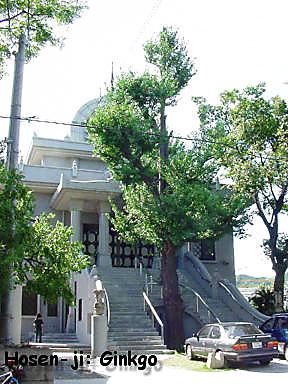-
Sylvhia.
User deleted
A living fossil: the Gingko Biloba
Have you ever walk in a park and feel a terrible smell that causes you to check the soles of your shoes to make sure that you have not beaten .... "a little gift"?
Well may be that you accidentally stepped on a seed of Gingko Biloba
The Ginkgo Biloba (also called Silver Apricot ) is a living fossil and the only species still surviving of Ginkgoaceae's family but also of the entire order of Ginkgoales (Engler 1898) and of the division of Ginkgophyta, a family of gymnosperms appeared during the Mesozoic Era which includes seven genus, six of which are extinct.
It 's the oldest living seed plant. In the wild it is likely present in some forests of China. Currently it is widely cultivated throughout the world.
The oldest fossils assigned to the genus Ginkgo date back to the Triassic (250 million years ago).
It is a tree that reaches a height of 30-40 m, up to 9 m wide foliage, pyramidal in young plants and oval in older specimens. The younger plants trunks have spread branches, more dense in adulthood, main branches are asymmetric tilted 45 °,and in yellow wood. The main branches lead many shorter branches, on which are placed leaves and fertile structures.
Young plants' bark is smooth and silver, it becomes gray-brown to dark brown and with a fissured texture in mature specimens.
The leaves,have the typical fan shape , slightly bilobed and with a high number of bifurcated ribs, about 5-8 cm, have a long stalk, and a light green colored lamina, which in the autumn assumes a yellow coloring very decorative. They are deciduous (falling during the winter). The leaf morphology varies depending on the location and age: the youger plants have deeply cut leaves, the leaves carried branches that have a very small step of the internodal distances, have inner margin and sometimes wavy, leaves carried by branches with long internodes and leaves well spaced are often lobed.
It does not have flowers . Gymnosperms do not have flowers but lead structures defined cones , as in this case modified scales (cones from a functional point of view can be considered similar to the flowers for homology).
It is a dioecious plant that is leading fertile male and female structures separated on different plants. In male cones the microsporangium are worn in pairs on microsporophills, spirally arranged on an elongated axis. Pollination is anemophilous ( wind dispersion)(Female Gender)
In the female cones ovums, initially two, then only one in the course of development, are carried on isolated stalks . The female plants therefore, unlike the majority of Gymnosperms (in particular of pinophyta), do not produce cones properly said structures but similar to these.(Male Gender)
Flowering is in spring. Between pollination and fertilization exist a few months. Fertilization takes place on the ground in early autumn, when the ovums have already fallen from the mother plant and have almost reached the final dimensions. The gametes are ciliates and mobile , as is the case in many less developed groups (Cycadophyta, mosses, ferns and algae).
The seeds (of which the embryo is edible after roasting) are 1.5-2 cm long and are covered with a fleshy wrap , yellow pruinose, with unpleasant odor when ripe (for the release of carboxylic acids, in particular butyric acid). Inside them there is a woody part that contains the embryo. Seed germination is epigeal.
Because of the unpleasant odor the gingko's female gender seeds emanate, for cultivation and planting in gardens or avenues, or even for growing Bonsai, male gender Gingko is preferred .Curiosity
Six specimens of Ginkgo, still existant, survived the radiation produced by the atomic bomb fell on the city of Hiroshima.HOSEN-JI

This Ginkgo situated near a temple about 1130 m away from the hypocenter appeared to bud after the blast (the temple itself was destroyed). The temple-site in Housenbou was smaller after the war and they considered transplanting or cutting down the Ginkgo to rebuild the temple. In 1994 it was decided to leave it there and adjust the temple to it, so now the main building has stairs in front divided into left-and right hand sides, protecting the Ginkgo inside this U-shape. Engraved on it "No more Hiroshima" and people's prayers for peace. This tree has thus become an international symbol. Estimated planting 1850, 15 m.
http://kwanten.home.xs4all.nl/hiroshima.htm
http://it.wikipedia.org/wiki/Ginkgo_biloba.
A living fossil: the Gingko Biloba02 Ottobre 2014 |



